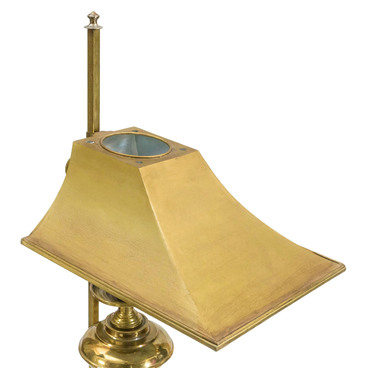The incense burner belonged to Dmitry Mamin-Sibiryak, and it is now on display in the house-museum, in a room devoted to the St. Petersburg period of his life. The writer received it as a gift from the theater director Vladimir Nemirovich-Danchenko.
The exhibit was kept by Mamin-Sibiryak’s wife, Olga Guvale. In 1916, she gave it to the Ural Society of Natural Science Lovers. Later, his collection became part of the Sverdlovsk Regional Museum of Local History. It was transferred to the writers’ house-museum in 1946.
The item is made of blue porcelain, painted and glazed on top. The master placed the figure of a small idol instead of the handle. The small idol is an adult man with a black tuft of hair, pulled back earlobes and a long beard.
The small idol is dressed in a blue robe with yellow spiral-shaped ornament; he has gilded slippers on his feet. The figure’s right arm and leg were lost, and with his left hand he holds onto the burner’s neck.
The body is decorated with the images of green fish, butterfly and black beetle. These elements are separated from each other by a cherry blossom branch that runs from the bottom to the edge of the neck.
The decoration of the burner had a meaning. In Eastern mythology, green-colored fish symbolized abundance, butterflies symbolized lovemaking and passion, and cherry blossoms symbolized good luck.
Dmitry Mamin-Sibiryak received other gifts from Nemirovich-Danchenko along with the burner, including glasses in a case and a picture frame. They are also kept in the collection of the house-museum.
Russian writers in the 19th century were seriously interested in Orientalism — Eastern culture, mythology and folklore. They appealed to motifs, plots and characters from Eastern literature.
Dmitry Mamin-Sibiryak was also interested in the oriental world. In the 1880s — 1890s he wrote “Oriental Legends”. It is a series of texts dedicated to folk heroes and legends. Five works were included: “Maya”, “Baymagan”, “The Swan of Khantygaya”, “Tears of the Tsarina” and “The Tale of the Siberian Khan Kuchum”. His sources were the legends and parables of the different peoples that inhabited the Russian Empire: the Turks, the Tatars, the Kirghiz and others.
The exhibit was kept by Mamin-Sibiryak’s wife, Olga Guvale. In 1916, she gave it to the Ural Society of Natural Science Lovers. Later, his collection became part of the Sverdlovsk Regional Museum of Local History. It was transferred to the writers’ house-museum in 1946.
The item is made of blue porcelain, painted and glazed on top. The master placed the figure of a small idol instead of the handle. The small idol is an adult man with a black tuft of hair, pulled back earlobes and a long beard.
The small idol is dressed in a blue robe with yellow spiral-shaped ornament; he has gilded slippers on his feet. The figure’s right arm and leg were lost, and with his left hand he holds onto the burner’s neck.
The body is decorated with the images of green fish, butterfly and black beetle. These elements are separated from each other by a cherry blossom branch that runs from the bottom to the edge of the neck.
The decoration of the burner had a meaning. In Eastern mythology, green-colored fish symbolized abundance, butterflies symbolized lovemaking and passion, and cherry blossoms symbolized good luck.
Dmitry Mamin-Sibiryak received other gifts from Nemirovich-Danchenko along with the burner, including glasses in a case and a picture frame. They are also kept in the collection of the house-museum.
Russian writers in the 19th century were seriously interested in Orientalism — Eastern culture, mythology and folklore. They appealed to motifs, plots and characters from Eastern literature.
Dmitry Mamin-Sibiryak was also interested in the oriental world. In the 1880s — 1890s he wrote “Oriental Legends”. It is a series of texts dedicated to folk heroes and legends. Five works were included: “Maya”, “Baymagan”, “The Swan of Khantygaya”, “Tears of the Tsarina” and “The Tale of the Siberian Khan Kuchum”. His sources were the legends and parables of the different peoples that inhabited the Russian Empire: the Turks, the Tatars, the Kirghiz and others.



